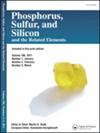Effect of replacing SiO2 with Sb2O3, Bi2O3, and Fe2O3 on the radiation shielding properties of lead sodium aluminum silicate glass
IF 1.4
4区 化学
Q4 CHEMISTRY, INORGANIC & NUCLEAR
Phosphorus, Sulfur, and Silicon and the Related Elements
Pub Date : 2025-07-03
DOI:10.1080/10426507.2025.2524191
引用次数: 0
Abstract
In this research, the radiation shielding coefficients for gamma rays were studied resulting from the addition of iron oxide (Fe2O3), antimony oxide (Sb2O3), and bismuth oxide (Bi2O3) to lead sodium aluminum silicate glass using the PHY-X/PSD simulation program at different energies (0.248, 0.347, 0.662, 0.826, 1.17, 1.33, 2.51 MeV) for four experimental compositions according to weight ratios: S1: 60 Pb3O4 − 32 SiO2 − 3 Al2O3 − 5 Na2SO4, S2: 60 Pb3O4 − 29 SiO2 − 3 Fe2O3 − 3 Al2O3 − 5 Na2SO4, S3: 60 Pb3O4 − 29 SiO2 − 3 Sb2O3 − 3 Al2O3 −5 Na2SO4, S4: 60 Pb3O4 − 29 SiO2 − 3 Bi2O3 − 3 Al2O3 − 5 Na2SO4. The results of PHY-X/PSD showed that sample S4 containing bismuth oxide had the best attenuation coefficients at all energies as compared to the other samples, followed by samples S2 and S3 containing iron oxide and antimony oxide, respectively, with approximately the same values of radiation shielding coefficients, and finally sample S1 without additives came. The X-COM results also showed that the photoelectric effect was effective at low energies, represented by the two values 0.248 and 0.347 MeV, while the Compton effect works strongly at medium energies, represented by the values of 0.662, 0.826, and 1.17 MeV, while the effect of pair production begins to appear at approximately 1.33 MeV, and its effect continues to increase as the energy value increases.

Sb2O3、Bi2O3和Fe2O3替代SiO2对铅钠铝硅酸盐玻璃辐射屏蔽性能的影响
在本研究中,采用PHY-X/PSD模拟程序研究了氧化铁(Fe2O3)、氧化锑(Sb2O3)和氧化铋(Bi2O3)以不同能量(0.248、0.347、0.662、0.826、1.17、1.33、2.51 MeV)添加到铅铝硅酸钠玻璃中所产生的伽马射线的辐射屏蔽系数,其质量比为:S1: 60 Pb3O4−32 SiO2−3 Al2O3−5 Na2SO4, S2;60 Pb3O4−29 SiO2−3 Fe2O3−3 Al2O3−5 Na2SO4, S3: 60 Pb3O4−29 SiO2−3 Sb2O3−3 Al2O3−5 Na2SO4, S4: 60 Pb3O4−29 SiO2−3 Bi2O3−3 Al2O3−5 Na2SO4。PHY-X/PSD结果表明,含氧化铋的样品S4在各能量下的衰减系数最好,其次是含氧化铁和氧化锑的样品S2和S3,两者的辐射屏蔽系数基本相同,最后是不含添加剂的样品S1。X-COM的结果还表明,光电效应在低能量下有效,分别为0.248和0.347 MeV两个值,而康普顿效应在中能量下作用强烈,分别为0.662、0.826和1.17 MeV,而对产生效应在1.33 MeV左右开始出现,并且随着能量值的增加,其作用继续增强。
本文章由计算机程序翻译,如有差异,请以英文原文为准。
求助全文
约1分钟内获得全文
求助全文
来源期刊
CiteScore
2.60
自引率
7.70%
发文量
103
审稿时长
2.1 months
期刊介绍:
Phosphorus, Sulfur, and Silicon and the Related Elements is a monthly publication intended to disseminate current trends and novel methods to those working in the broad and interdisciplinary field of heteroatom chemistry.

 求助内容:
求助内容: 应助结果提醒方式:
应助结果提醒方式:


